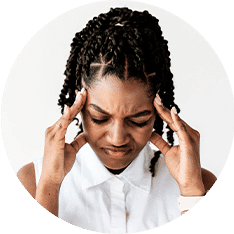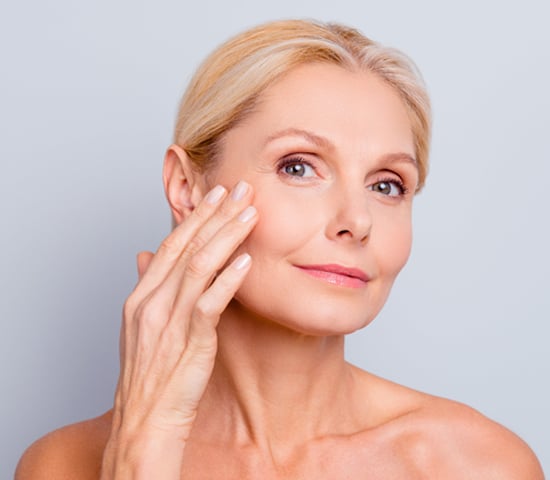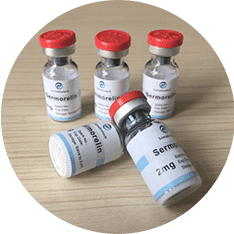
Unlock a More Youthful You With Hormone Replacemment Therapy In Lower East Side, NY
Aging is inevitable, and for many, it signals the beginning of a new chapter - one where you cross off bucket list items and live life to the fullest, on your own terms. However, for some women, aging is a horrible prospect, filled with chronic fatigue, irritability, and inability to perform in the bedroom. If you're concerned about life in middle age and beyond, we've got great news: there are easy, proven steps that you can take to help stop the negative effect of aging.
Global Life Rejuvenation was founded to give women a new lease on life - one that includes less body fat, fewer mood swings, and more energy as you age. If you're ready to look and feel younger, it's time to consider HRT (hormone replacement therapy), and growth hormone peptides. These therapies for men and women are effective, safe, and customized to fit your goals, so you can keep loving life as you get older.
HRT, and growth hormone peptide therapies bridge the gap between your old life and the more vibrant, happier version of you. With a simple click or call, you can be well on your way to a brighter future. After all, you deserve to be the one in charge of your wellness and health. Now, you have the tools to do so - backed by science and applied by our team of HRT experts with more than 13 years of experience.
What is HRT?
As women age, their hormones begin to go through changes that affect their day-to-day lives. For women, hormone deficiency and imbalance usually occur during menopause and can cause chronic fatigue, hot flashes, and mood swings, among other issues. Hormone replacement therapy helps correct hormone imbalances in women, helping them feel more vibrant and virile as they age.
Often, HRT treatments give patients enhanced quality of life that they didn't think was possible - even in their 60's and beyond.
The benefits for women are numerous and are available today through Global Life Rejuvenation.
HORMONE REPLACEMENT THERAPY
HRT and Anti-Aging Medicine for Women in Lower East Side, NY
As women age, their bodies begin to go through significant changes that affect their quality of life. This change is called menopause and marks the end of a woman's menstrual cycle and reproduction ability. Though there is no specific age when this change occurs, the average age of menopause onset is 51 years old. However, according to doctors, menopause officially starts 12 months after a woman's final period. During the transition to menopause, women's estrogen and other hormones begin to deplete.
As that happens, many women experience severe symptoms. These symptoms include:
- Hot Flashes
- Chronic Fatigue
- Incontinence
- Trouble Sleeping
- Dryness
- Muscle Loss
- Fat Gain
- Mood Swings
The symptoms of hormone deficiency can be concerning and scary for both women and their spouses. However, if you're getting older and notice some of these symptoms, there is reason to be hopeful. Hormone replacement therapy and anti-aging medicine for women can correct imbalances that happen during menopause. These safe, effective treatments leave you feeling younger, healthier, and more vibrant.


What Causes Menopause?
The most common reason for menopause is the natural decline in a female's reproductive hormones. However, menopause can also result from the following situations:
Oophorectomy: This surgery, which removes a woman's ovaries, causes immediate menopause. Symptoms and signs of menopause in this situation can be severe, as the hormonal changes happen abruptly.
Chemotherapy: Cancer treatments like chemotherapy can induce menopause quickly, causing symptoms to appear shortly after or even during treatment.
Ovarian Insufficiency: Also called premature ovarian failure, this condition is essentially premature menopause. It happens when a woman's ovaries quit functioning before the age of 40 and can stem from genetic factors and disease. Only 1% of women suffer from premature menopause, but HRT can help protect the heart, brain, and bones.
Common Issues for Women During Menopause
For many women, menopause is a trying time that can be filled with many hormonal hurdles to jump through. A little knowledge can go a long way, whether you're going through menopause now or are approaching "that" age.
Here are some of the most common issues that women experience during menopause:

Depression
If you're a woman going through menopause and find that you have become increasingly depressed, you're not alone. It's estimated that 15% of women experience depression to some degree while going through menopause. What many women don't know is that depression can start during perimenopause, or the years leading up to menopause.
Depression can be hard to diagnose, especially during perimenopause and menopause. However, if you notice the following signs, it might be time to speak with a physician:
- Mood Swings
- Inappropriate Guilt
- Chronic Fatigue
- Too Much or Too Little Sleep
- Lack of Interest in Life
- Overwhelming Feelings
Remember, if you're experiencing depression, you're not weak or broken - you're going through a very regular emotional experience. The good news is that with proper treatment from your doctor, depression isn't a death sentence. And with HRT and anti-aging treatment for women, depression could be the catalyst you need to enjoy a new lease on life.

Hot Flashes
Hot flashes - they're one of the most well-known symptoms of menopause. Hot flashes are intense, sudden feelings of heat across a woman's upper body. Some last second, while others last minutes, making them incredibly inconvenient and uncomfortable for most women.
Symptoms of hot flashes include:
- Sudden, Overwhelming Feeling of Heat
- Anxiety
- High Heart Rate
- Headache
- Nausea
- Dizziness
Typically, hot flashes are caused by a lack of estrogen. Low estrogen levels negatively affect a woman's hypothalamus, the part of the brain that controls body temperature and appetite. Low estrogen levels cause the hypothalamus to incorrectly assume the body is too hot, dilating blood vessels to increase blood flow. Luckily, most women don't have to settle for the uncomfortable feelings that hot flashes cause. HRT treatments for women often stabilize hormones, lessening the effects of hot flashes and menopause in general.

Mood Swings
Mood swings are common occurrences for most people - quick shifts from happy to angry and back again, triggered by a specific event. And while many people experience mood swings, they are particularly common for women going through menopause. That's because, during menopause, the female's hormones are often imbalanced. Hormone imbalances and mood swings go hand-in-hand, resulting in frequent mood changes and even symptoms like insomnia.
The rate of production of estrogen, a hormone that fluctuates during menopause, largely determines the rate of production the hormone serotonin, which regulates mood, causing mood swings.
Luckily, HRT and anti-aging treatments in Lower East Side, NY for women work wonders for mood swings by regulating hormone levels like estrogen. With normal hormone levels, women around the world are now learning that they don't have to settle for mood swings during menopause.

Weight Gain
Staying fit and healthy is hard for anyone living in modern America. However, for women with hormone imbalances during perimenopause or menopause, weight gain is even more serious. Luckily, HRT treatments for women coupled with a physician-led diet can help keep weight in check. But which hormones need to be regulated?
- Estrogen: During menopause, estrogen levels are depleted. As such, the body must search for other sources of estrogen. Because estrogen is stored in fat, your body believes it should increase fat production during menopause. Estrogen also plays a big part in insulin resistance, which can make it even harder to lose weight and keep it off.
- Progesterone: Progesterone levels are also depleted during menopause. Progesterone depletion causes bloating and water retention, while loss of testosterone limits the body's ability to burn calories.
- Ongoing Stress: Stress makes our bodies think that food is hard to come by, putting our bodies in "survival mode". When this happens, cortisol production is altered. When cortisol timing changes, the energy in the bloodstream is diverted toward making fat. With chronic stress, this process repeatedly happens, causing extensive weight gain during menopause.

Low Libido
Lowered sexual desire - three words most men and women hate to hear. Unfortunately, for many women in perimenopausal and menopausal states, it's just a reality of life. Thankfully, today, HRT and anti-aging treatments Lower East Side, NY can help women maintain a normal, healthy sex drive. But what causes low libido in women, especially as they get older?
The hormones responsible for low libido in women are progesterone, estrogen, and testosterone.
Progesterone production decreases during perimenopause, causing low sex drive in women. Lower progesterone production can also cause chronic fatigue, weight gain, and other symptoms. On the other hand, lower estrogen levels during menopause lead to vaginal dryness and even vaginal atrophy or loss of muscle tension.
Lastly, testosterone plays a role in lowered libido. And while testosterone is often grouped as a male hormone, it contributes to important health and regulatory functionality in women. A woman's testosterone serves to heighten sexual responses and enhances orgasms. When the ovaries are unable to produce sufficient levels of testosterone, it often results in a lowered sex drive.

Vaginal Dryness
Often uncomfortable and even painful, vaginal dryness is a serious problem for sexually active women. However, like hair loss in males, vaginal dryness is very common - almost 50% of women suffer from it during menopause.
Getting older is just a part of life, but that doesn't mean you have to settle for the side effects. HRT and anti-aging treatments for women correct vaginal dryness by re-balancing estrogen, progesterone, and testosterone. When supplemented with diet and healthy living, your vagina's secretions are normalized, causing discomfort to recede.

Fibroids
Uterine fibroids - they're perhaps the least-known symptom of menopause and hormone imbalances in women. That's because these growths on the uterus are often symptom-free. Unfortunately, these growths can be cancerous, presenting a danger for women as they age.
Many women will have fibroids at some point. Because they're symptomless, they're usually found during routine doctor exams. Some women only get one or two, while others may have large clusters of fibroids. Because fibroids are usually caused by hormone imbalances, hysterectomies have been used as a solution, forcing women into early menopause.
Advances in HRT and anti-aging medicine for women give females a safer, non-surgical option without having to experience menopause early. At Global Life Rejuvenation, our expert physicians will implement a customized HRT program to stabilize your hormones and reduce the risk of cancerous fibroid growth.

Endometriosis
Endometriosis symptoms are much like the effects of PMS, and include pelvic pain, fatigue, cramping, and bloating. While doctors aren't entirely sure what causes this painful, uncomfortable condition, most agree that hormones - particularly xenoestrogens - play a factor.
Endometriosis symptoms are much like the effects of PMS and include pelvic pain, fatigue, cramping, and bloating. While doctors aren't entirely sure what causes this painful, uncomfortable condition, most agree that hormones - particularly xenoestrogens - play a factor.
Xenoestrogen is a hormone that is very similar to estrogen. Too much xenoestrogen is thought to stimulate endometrial tissue growth. HRT for women helps balance these hormones and, when used with a custom nutrition program, can provide relief for women across the U.S.
Is HRT for Women the Right Answer?
Hormone stability is imperative for a healthy sex drive and for a normal, stress-free life during menopause. HRT and anti-aging treatments for women balance the hormones that your body has altered due to perimenopause or menopause.
HRT for women is a revolutionary step in helping women live their best lives, even as they grow older. However, at Global Life Rejuvenation, we know that no two patients are the same. That's why we specialize in holistic treatments that utilize HRT, combined with healthy nutrition, supplements, and fitness plans that maximize hormone replacement treatments.
If you've been suffering through menopause, is HRT the answer? That's hard to say without an examination by a trusted physician, but one thing's for sure. When a woman balances her hormone levels, she has a much better shot at living a regular life with limited depression, weight gain, mood swings, and hot flashes.
Here are just a few additional benefits of HRT and anti-aging treatments for females:


Benefits of HRT and Anti-Aging Medicine for Women in Lower East Side, NY
Hormone imbalance causes a litany of issues. But with anti-aging treatments for women, females can better process calcium, keep their cholesterol levels safe, and maintain a healthy vagina. By replenishing the body's estrogen supply, HRT can relieve symptoms from menopause and protect against osteoporosis. But that's just the start.
Global Life Rejuvenation's patients report many more benefits of HRT and anti-aging medicine for women:
- Fewer Mood Swings
- Thicker Hair
- Stronger Bones
- Less Body Fat
- More Energy
- More Stamina
- Increased Sex Drive and Pleasure Sensations
- Better Cognitive Functions
- Improved Pain Receptors
- Less Hot Flashes and Night Sweats
- Lower Triglycerides
- Fewer Bladder Infections
If you're ready to feel better, look better, and recapture the vitality of your youth, it's time to contact Global Life Rejuvenation. It all starts with an in-depth consultation, where we will determine if HRT and anti-aging treatments for women are right for you. After all, every patient's body and hormone levels are different. Since all our treatment options are personalized, we do not have a single threshold for treatment. Instead, we look at our patient's hormone levels and analyze them on a case-by-case basis.

HRT from Global Life Rejuvenation
At Global Life Rejuvenation, we help women rediscover their youth with HRT treatment for women. We like to think of ourselves as an anti-aging concierge service, guiding and connecting our patients to the most qualified HRT physicians available. With customized HRT treatment plan for women, our patients experience fewer menopausal symptoms, less perimenopause & menopause depression, and often enjoy a more youth-like appearance.
Reverse Aging with Growth Hormone Peptides
Growth hormone peptides are an innovative therapy that boosts the natural human growth hormone production in a person's body. These exciting treatment options help slow down the aging process and give you a chance at restoring your youth.

What is Sermorelin?
Sermorelin is a synthetic hormone peptide, like GHRH, which triggers the release of growth hormones. When used under the care of a qualified physician, Sermorelin can help you lose weight, increase your energy levels, and help you feel much younger.

Benefits of Sermorelin
Human growth hormone (HGH) therapy has been used for years to treat hormone deficiencies. Unlike HGH, which directly replaces declining human growth hormone levels, Sermorelin addresses the underlying cause of decreased HGH, stimulating the pituitary gland naturally. This approach keeps the mechanisms of growth hormone production active.
- Benefits of Sermorelin include:
- Better Immune Function
- Improved Physical Performance
- More Growth Hormone Production
- Less Body Fat
- Build More Lean Muscle
- Better Sleep

What is Ipamorelin?
Ipamorelin helps to release growth hormones in a person's body by mimicking a peptide called ghrelin. Ghrelin is one of three hormones which work together to regulate the growth hormone levels released by the pituitary gland. Because Ipamorelin stimulates the body to produce growth hormone, your body won't stop its natural growth hormone production, which occurs with synthetic HGH.
Ipamorelin causes growth hormone secretion that resembles natural release patterns rather than being constantly elevated from HGH. Because ipamorelin stimulates the natural production of growth hormone, our patients can use this treatment long-term with fewer health risks.

Benefits of Ipamorelin
One of the biggest benefits of Ipamorelin is that it provides significant short and long-term benefits in age management therapies. Ipamorelin can boost a patient's overall health, wellbeing, and outlook on life.
When there is an increased concentration of growth hormone by the pituitary gland, there are positive benefits to the body. Some benefits include:
- Powerful Anti-Aging Properties
- More Muscle Mass
- Less Unsightly Body Fat
- Deep, Restful Sleep
- Increased Athletic Performance
- More Energy
- Less Recovery Time for Training Sessions and Injuries
- Enhanced Overall Wellness and Health
- No Significant Increase in Cortisol
Your New, Youthful Lease on Life with HRT for Women
Whether you are considering our HRT and anti-aging treatments for women in Lower East Side, NY, we are here to help. The first step to reclaiming your life begins by contacting Global Life Rejuvenation. Our friendly, knowledgeable HRT experts can help answer your questions and walk you through our procedures. From there, we'll figure out which treatments are right for you. Before you know it, you'll be well on your way to looking and feeling better than you have in years!
 866-793-9933
866-793-9933
Request a Consultation
Latest News in Lower East Side, NY
Williamsburg Bar Maison Premiere Opens a Cocktail Lounge on the Lower East Side
Emma Orlowhttps://ny.eater.com/2023/11/15/23954355/tigre-opens-maison-premiere-lower-east-side-manhattan
Maison Premiere, Williamsburg’s New Orleans-inspired cocktail bar, has opened a Manhattan sibling. Tigre is located at 105 Rivington Street, at Ludlow Street, on the Lower East Side. William Elliott, bar director at Maison Premiere, will likewise oversee the beverage menu — which pulled ideas from Playboy’s Host & Bar Book — at...
Maison Premiere, Williamsburg’s New Orleans-inspired cocktail bar, has opened a Manhattan sibling. Tigre is located at 105 Rivington Street, at Ludlow Street, on the Lower East Side. William Elliott, bar director at Maison Premiere, will likewise oversee the beverage menu — which pulled ideas from Playboy’s Host & Bar Book — at Tigre. Cocktails have names like the Rolls Royce and Mister Softee, there are also “Martinis by Ratio” which allows guests to “tailor their martini preferences with precision, with options ranging from 4:1 to 16:1.” The space features a horseshoe-shaped bar, in a space that hopes to evoke “residential sexiness in New York from the 1970s, ’80s, and maybe even ’90s,” according to Grub Street. Co-founders Joshua Boissy and Krystof Zizka’s Maison Premiere has been heaped with accolades since opening in 2011. This spring, they published The Maison Premiere Almanac, a cocktail book. Financial troubles have also hung above the group. In 2019, Eater reported the Williamsburg bar and its now-closed restaurant Sauvage were millions of dollars in debt and had filed for bankruptcy protection. In Manhattan, Tigre is open Sundays through Wednesdays, 6 p.m. to 1 a.m.; Thursdays through Saturday, until 2 a.m.
Gran Electrica couple opens a Greenpoint restaurant
Rick Curi and Itir Aloba, owners of Gran Electrica, a Dumbo Mexican restaurant, are opening a new spot. The Noble opens this weekend with cuisine referencing the Aegean region like chilled shrimp with lemon crushed fava, zucchini fritters, grilled octopus, and seared halloumi. Josh Lucio Lasso, who previously worked at Public Records and Ensenada, is leading the kitchen as executive chef. He’s joined by general manager and sommelier Miles Meltz, previously of Ci Siamo. The Noble is located at 148 Noble Street, at Lorimer Street in Greenpoint.
Silver Apricot team expands in the West Village
Figure Eight opens today, from the team behind neighboring Silver Apricot. The new restaurant pulls from owner Emmeline Zhao’s heritage, mixing Chinese and American Southern cuisines. Figure Eight’s kitchen is led by Calvin Hwang (formerly of Saga and Crown Shy). The menu lists turnip tots, a “breakfast chowder” with youtiao, and a crab pimento dip. A mini tempura lobster roll pays homage to the restaurant’s former tenant: Pearl Oyster Bar. Figure Eight is located at 18 Cornelia Street, near Bleecker Street, in the West Village. It opens tonight, November 15.
Manhattan now has an outpost of this Brooklyn pizzeria
Things are heating up in the Downtown Manhattan slice shop scene. Just as L’Industrie has opened its first Manhattan outpost, so, too, has Lucia Pizza. The slice shop, which first opened last year from Salvatore Carlino in Sheepshead Bay, opens today at 375 Canal Street, at West Broadway, in Soho.
Lower East Side Ecology Center Nurtures Sustainability in Urban Communities
Sycamore Mayhttps://www.nycfoodpolicy.org/lower-east-side-ecology-center-nurtures-sustainability-in-urban-communities/
Part of the Food Policy Community Spotlight SeriesName: Lower East Side Ecology CenterWhat they do: The Lower East Side (LES) Ecology Center is a nonprofit organization committed to fostering environmental awareness and sustainability in urban communities, with a particular focus on the Lower East Side of Manhattan. They strive to promote ecological responsibility through recycling initiati...
Part of the Food Policy Community Spotlight Series
Name: Lower East Side Ecology Center
What they do: The Lower East Side (LES) Ecology Center is a nonprofit organization committed to fostering environmental awareness and sustainability in urban communities, with a particular focus on the Lower East Side of Manhattan. They strive to promote ecological responsibility through recycling initiatives, educational programs, and community engagement, working to create a greener, more resilient, and equitable city.
How they do it: The LES Ecology Center implements a range of initiatives to achieve their goals. They operate 20 food scrap drop-off sites across the city, where residents can drop-off their food scraps for composting which then turn into finished compost for local parks, gardens and urban farming projects. They also offer electronics recycling opportunities to protect the city’s land, water and air from pollution. Additionally, the center conducts environmental education workshops and training programs, advocating for waste reduction, recycling best practices, and sustainable living choices.
Latest project/campaign: The Ecology Center’s Food Justice Program was launched in 2021 to create an educational and food-producing garden in partnership with the Henry Street Settlement. At the Food Justice Garden, participants learn about food systems and how food access impacts individual, community, and environmental health. Additionally, participants practice skills in growing and cooking food to prepare nutritious and seasonal meals. All food produced in this space is used in education workshops or shared in the local community fridges.
Major Funding: Government
Profit/nonprofit: Nonprofit
Annual Budget: $2.4 million
Interesting fact about how it is working to positively affect the food system: The Ecology Center’s Food Justice Program is impacting the food systems by empowering Lower East Side youth with awareness to make healthy, sustainable consumer food choices. For example, the 2023 summer youth cohort partnered with Chefs for Impact to learn how to source local and seasonal produce from the farmers market while getting to know the vendors and farmers, and turn the ingredients into homemade meals such as pesto pasta, curries, fruit salad, corn cakes, and more!
FACT SHEET:
Location: New York City, NY, USA
Core Programs:
Number of staff: 18
Number of volunteers: 900
Areas served: Primarily focuses on the Lower East Side of Manhattan, while also collaborating with other neighborhoods and communities within New York City.
Year Started: 1987
Director: Christine Datz-Romero
Contact Information: [email protected]; (212) 477-4022
Opinion: Congestion pricing would fuel pollution on Lower East Side
The Village Sunhttps://thevillagesun.com/opinion-congestion-pricing-would-fuel-pollution-on-les
December 3, 2023BY KATHRYN FREED | Congestion pricing is coming. Most people either love it or hate it. Most of us acknowledge the need to reduce traffic and pollution, but are not sure the current proposal does that. This op-ed will examine the plan’s impacts on the Lower East Side, specifically the area next to the F.D.R. Drive from the Brooklyn Bridge to E. 10th Street.Congestion pricing (CP) was passed by the New York State Legislature and signed into effect in April 2019. The intent was to raise mone...
December 3, 2023
BY KATHRYN FREED | Congestion pricing is coming. Most people either love it or hate it. Most of us acknowledge the need to reduce traffic and pollution, but are not sure the current proposal does that. This op-ed will examine the plan’s impacts on the Lower East Side, specifically the area next to the F.D.R. Drive from the Brooklyn Bridge to E. 10th Street.
Congestion pricing (CP) was passed by the New York State Legislature and signed into effect in April 2019. The intent was to raise money, about $1 billion per year, up to at least $15 billion, for the transit system, and devise a scheme to cut the number of vehicles in the Central Business District by tolling vehicles that enter it. The CBD is Manhattan from the Battery to 60th Street, minus the F.D.R. Drive, the West Side Highway and the Hugh Carey (Brooklyn-Battery) Tunnel.
In June, after fast-tracking by the Biden administration, New York State got the go-ahead to proceed with CP, after an Environmental Assessment rather than a more stringent Environmental Impact Statement. Several federal lawsuits have been filed contesting this determination, most notably by New Jersey. Several more are in the works. One group is actively exploring suing based on what it calls a tax on city residents, especially those living in or near the CBD. For more information on that group, check stopcongestionpricing.com.
The Metropolitan Transportation Authority, recognizing the projected additional pollution CP would cause in the South Bronx, has agreed to provide around $130 million in mitigation measures, including an asthma center, to try to reduce pollution or its impact on South Bronx residents. The M.T.A. has represented that it has about $20 million to deal with the effects of pollution in Manhattan, especially in the CBD.
But the M.T.A. has not indicated it’s willing to make any special efforts to reduce pollution on the Lower East Side, even though its own projections show CP will drastically increase traffic and pollution in parts of our community. The E.A. established seven alternative-pricing schemes and one “No Action” proposal. Each scheme, according to the M.T.A.’s own figures, would raise congestion and pollution amounts in the area — along the F.D.R. Drive, Brooklyn Bridge to 10th Street — at least 5 percent or greater. And, incredibly, in at least three alternatives, pollution and congestion in the F.D.R.’s southbound traffic would increase from 19 percent to 26 percent.
So, while the rest of the CBD will see fewer vehicles and less pollution, our area will get an increase. Even more outrageous, this area by the F.D.R. is an Environmental Justice Area (E.J.A.). An E.J.A. is defined as a place where at least 51 percent of the population is minority and at least 23.5 percent of that group has an income lower than the rest of the population. In fact, every census tract but one in this area is an E.J.A. According to Community Board 3, roughly 42 percent of the population in the C.B. 3 district is below the poverty level, 46 percent of seniors are below the poverty level, and about 44 percent are minorities, the latter comprising 81 percent of the population below the poverty level. (Normally, I would say “People of Color,” but the tables specifically use the term “minority.”)
We need fewer cars — not an asthma center.
There is an almost solid wall of limited-income or low-income buildings next to the F.D.R. Drive here, mostly New York City Housing Authority. The one census tract (including East River Houses co-ops) not considered an E.J.A. was built as limited-income, and today many of its original residents are on limited incomes. It’s also a NORC (Naturally Occurring Retirement Community), like much of the rest of the area. Finally, at least 18 percent of area residents have a disability.
Most appalling, this area already has among Manhattan’s highest levels of asthma and respiratory disease and heart disease. It also had an above-average rate of COVID and COVID deaths. Plus, a general medical study (not just for our area) released last month found there are greater premature births and low birth rates in highly polluted zones.
In other words, high pollution is not compatible with human health. So, you could hardly find a worse area on which to inflict more pollution, given residents’ already diminished health and welfare.
Making the situation worse, we are on track to lose 55 acres of mature parkland and well more than 1,000 trees due to the East Side Coastal Resiliency plan. We’ve already lost half of the park in the project’s phase one. It’s a cruel irony that residents next to this project are also being subjected to additional dust and pollution as that construction occurs.
I am totally outraged. Why is no one else screaming about this appalling situation? We need real mitigation — and I don’t mean an asthma center. We won’t accept additional pollution when the rest of the CBD is getting less. This will damage our health and our children’s health. The time to demand change is now, before the final plans are made.
We also should demand that more trees, specifically, more mature trees, be planted in the East River Park area. Right now, only saplings are proposed; it will take 20 to 30 years to get both pollution protection and shade from these saplings equal to that of the old East River Park. We also need more grass and natural surfaces for the park. Plants soak up water and capture carbon; they actually produce oxygen while lowering pollution and greenhouse gasses. Currently, park plans call for 62 percent hard and artificial surfaces, which do none of these things. (I could go on about artificial turf’s dangers and disadvantages, and why pro sports teams are demanding natural turf, or why many American cities are banning fake turf.)
Finally, here’s the best thing that could be done for this neighborhood: decking over portions of the F.D.R. Drive and installing air filters to remove the highway’s pollution — pollution that’s already too high. We could put playing fields on top, maybe even connect it to the reconstructed East River Park.
This deck could possibly even house surface mass transportation, like a Second Avenue subway extension. If you’re worried about your view next to the former park, remember, there will be a new floodwall there 8 feet to 10 feet tall anyway.
Also, as long as the F.D.R. Drive is subject to flooding, it is more and more likely that its infrastructure is eroding and will need replacement. Yet, the park coastal resiliency project does nothing to alleviate the impact of heavy rainfall.
After September’s downpour, three of four buildings in my co-op, which is right next to the F.D.R., flooded. It was worse than what happened during Hurricane Sandy. Adding larger catch basins next to and under the F.D.R. could help prevent flooding. Why not make real change? Just an idea.
Furthermore, our district is a “transit desert,” roughly described as any area where it takes more than 15 minutes to reach a bus or a subway. I can say from personal experience that it takes at least 15 minutes to get to a subway from my block next to the F.D.R. Drive. Although the bus stops are closer, a look at the Manhattan subway or bus maps, shows that we have far fewer buses, and the ones that we have tend to stick to the periphery of heavily populated areas. Most of us must walk to a bus to get to the subway. Not to mention, if you use the bus, you know how sporadic the service is. This does nothing to help the mobility disadvantaged. On top of which, we have absolutely no accessible subways. Were we promised them? Yes. Did we get it? No.
Freed is a retired State Supreme Court justice and former city councilmember representing Lower Manhattan’s District 1 from 1992 to 2001. She was co-counsel on a community lawsuit seeking to block East River Park’s destruction for the East Side Coastal Resiliency plan.
Salted white coffee at Kopitiam on the Lower East Side | Neighborhood Eats
Eyewitness Newshttps://abc7ny.com/kopitiam-lower-east-side-coffee-shop-malaysia/14310248/
LOWER EAST SIDE, Manhattan (WABC) -- This week's Neighborhood Eats travels to Kopitiam on the Lower East Side of Manhattan.It's where Chef Kyo Pang makes the Baba Nonya cuisine she ate growing up, a hybrid of Chinese and Malaysian flavors.It's her homage to the coffee shops of Malaysia and Kopitiam means coffee shop.It has a warmth and menu that extend far beyond its delicious cup of salted white coffee.Chef...
LOWER EAST SIDE, Manhattan (WABC) -- This week's Neighborhood Eats travels to Kopitiam on the Lower East Side of Manhattan.
It's where Chef Kyo Pang makes the Baba Nonya cuisine she ate growing up, a hybrid of Chinese and Malaysian flavors.
It's her homage to the coffee shops of Malaysia and Kopitiam means coffee shop.
It has a warmth and menu that extend far beyond its delicious cup of salted white coffee.
Chef Kyo, who is from Penang, shared with us that in Malaysia, they don't have separate breakfast, lunch, and dinner foods, you can have soup and rice dishes in the morning and toast at night, there's no category.
So they serve up all those dishes, the kaya toast, Nasi Lemak, and fish ball soup, all day long.
"Everything in the restaurant is basically everything that I love," Pang said. "This is a taste that I was eating when I was growing up and every single dish has a story."
She described some of her favorite dishes.
"The Nasi Lemak is the national dish of Malaysia. Anchovies, peanuts, coconut rice, cucumbers, eggs, and a side of sambal," she said. "Nothing simpler than that but when they all mix together, you would be amazed, they actually work so well with each other."
She says the key to their success, is keeping it simple, yet beautiful.
"Our cuisine is colorful, flavorful, and we try to work with the simple ingredients and try to bring out the most harmonious relationship with one another," Pang said.
Our cuisine is colorful, flavorful, and we try to work with the simple ingredients and try to bring out the most harmonious relationship with one another.Chef Kyo Pang
One dish in her mind reigns supreme.
"The Kaya Toast is actually my favorite. We make our own jam, the kaya jam, and also the bread we make from our own recipe. It's crunchy on the outside, fluffy in the middle and the jam is green because we use pandang leaves," she said. "We don't use any food coloring so we use the natural ingredients, natural colors put into our thing."
Another of their featured items has a special meaning: "The blue sticky rice with the grated coconut we call it pulut inti, because pulu means wrapped," she said. "We express a lot of philosophies and also life lessons through our cooking so this is the feelings that was wrapped inside this sticky rice."
If you are looking for a beverage to pair with any of these items, they are known for their white coffee.
"This is our white coffee, the white coffee that we do exclusively here is salted white coffee. In South East Asia all of our to-go drinks are served in bags," Pang said. "The truck driver would hang this in front of the mirror so when they drive they saw this thing and it reminded them to drink water. Or people cycling, they cannot hold a cup so they hang it on the bike and they can do their job, this is how it is, it's one of the Malaysian traditions, yes."
When you visit the restaurant, they want you to feel like you are family.
"I think the vibe that we carry here at Kopitiam is like a grandparent's house," Pang said. "Always welcoming you with the same, warming heart, no matter you have a good day, bad day, come in, nobody judge you."
Always welcoming you with the same, warming heart, no matter you have a good day, bad day, come in, nobody judge you.Chef Kyo Pang
Below, listen and subscribe to the "Mornings @ 10" podcast!
----------
* Download the abc7NY app for breaking news alerts
Submit a tip or story idea to Eyewitness News
Have a breaking news tip or an idea for a story we should cover? Send it to Eyewitness News using the form below. If attaching a video or photo, terms of use apply.
The best New York hotels for 2024
Laura Itzkowitzhttps://www.cntraveller.com/gallery/new-york-hotels
For a city that claims to never sleep, there are hundreds – over 500 according to Booking.com – of places to rest your head for the night. Some are much more than just places to sleep; a special few are even integral to the city’s identity, with historic addresses such as the Plaza and the Waldorf Astoria playing starring roles in New York’s cityscape, plus some of the most beloved TV shows and films. The grand d...
For a city that claims to never sleep, there are hundreds – over 500 according to Booking.com – of places to rest your head for the night. Some are much more than just places to sleep; a special few are even integral to the city’s identity, with historic addresses such as the Plaza and the Waldorf Astoria playing starring roles in New York’s cityscape, plus some of the most beloved TV shows and films. The grand dames may last the test of time, but much of New York’s hotel scene is in a state of constant flux. New addresses pop up regularly and old ones are revamped to keep up with the changing trends. The scope of the best hotels in New York grows wider too, branching out well beyond the usual Time Square addresses, venturing downtown and even over the bridges.
What’s the best part of New York to stay in?
Locals will tell you to skip staying near Time Square, the soulless midtown monstrosity is a classic tourist trap with much hype but little to offer. If it’s your first time in New York or a whistle-stop trip, a hotel in midtown could be your best option for ease of getting around. But if you’re looking for a glimpse of real New York and its many personalities, some of the best hotels in New York are found outside of Midtown, like The Carlyle on the Upper East Side or PUBLIC hotel on the Lower East. Some of the city’s hottest addresses have even started to pop up outside of Manhattan, with Ace Hotel and 1 Hotel now with locations in Brooklyn and even Boro Hotel in Long Island City.
How we choose the best hotels in New York
Every hotel on this list has been selected independently by our editors and written by a Condé Nast Traveller journalist who knows the destination and has stayed at that property. When choosing hotels, our editors consider both luxury properties and boutique and lesser-known boltholes that offer an authentic and insider experience of a destination. We’re always looking for beautiful design, a great location and warm service – as well as serious sustainability credentials. We update this list regularly as new hotels open and existing ones evolve.
See more of our New York recommendations:
Disclaimer:


